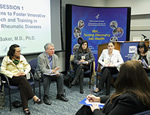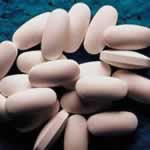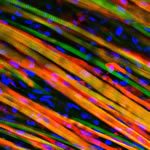Spotlight
Letter from Dr. Stephen I. Katz: Growing our Social Media Presence
In July 2012, I wrote about our new use of social media tools to help spread the word about research conducted and supported by the NIAMS. At that time, our social media efforts were still in their infancy, but they have grown up fast! We continue to post daily updates and tweets about our publications, scientific advances and other news stories. We also maintain a strong social media presence at conferences and scientific meetings.
Image: Stephen I. Katz, M.D., Ph.D.
News
National Institutes of Health (NIH) Scientist To Receive Ross Prize in Molecular Medicine
John J. O’Shea, M.D., scientific director at the NIAMS, has been named the 2014 recipient of the Ross Prize in Molecular Medicine, conferred by the Feinstein Institute’s peer-reviewed, open-access journal Molecular Medicine. The award will be given on June 9, 2014, at the New York Academy of Sciences in Manhattan, followed by scientific presentations by Dr. O’Shea and other prominent researchers.
International Team Identifies Biomarker for Scleroderma
A higher level of a small signaling molecule correlates with a more severe form of scleroderma, a chronic autoimmune disorder that involves the abnormal growth of connective tissue, according to a study funded in part by the NIAMS and published in the New England Journal of Medicine. The findings suggest that the molecule, CXCL4, could be used as a diagnostic marker for the disease and as a therapeutic target.
Bone Hormone Found to Influence Brain Development and Function in Mice
A hormone produced in bone influences pre-natal brain development and cognitive function in mice, according to research funded in part by the NIAMS. The study was published in the journal Cell. Bone communicates with other tissues and organs in various ways. For instance, it is known that the bone-derived hormone osteocalcin regulates insulin production and male fertility. In addition, bone receives signals from the central nervous system, likely through the network of nerves that runs throughout bone’s cellular matrix.
Research Consortium Including NIH Proposes Diagnostic Criteria for Sarcopenia: Condition Leads to Disability in Many Older Adults
Sarcopenia, a loss of muscle mass often associated with weakness, is a commonly recognized cause of disability in older people. However, without consensus on ways to specifically measure this condition, the development of interventions for sarcopenia has been challenging. Now, a team of researchers proposes a comprehensive set of diagnostic criteria, presented April 15, 2014, in six special articles in the Journals of Gerontology: Medical Sciences.
Muscle Weakness Seen in Alcoholism Linked to Mitochondrial Repair Issues
Muscle weakness from long-term alcoholism may stem from an inability of mitochondria, the powerhouses of cells, to self-repair, according to a study funded by the NIH. In research conducted with rats, scientists found evidence that chronic heavy alcohol use affects a gene involved in mitochondrial repair and muscle regeneration.
NIAMS Coalition Web Pages Updated
The NIAMS Coalition is now more prominently featured on the NIAMS website. The NIAMS Coalition is an independent consortium of professional and voluntary organizations that are national in scope. These organizations raise awareness about NIAMS research into the basic understanding, causes, incidence, treatment and prevention of diseases of the bones, joints, muscles and skin. They are key partners of the NIAMS and serve as the voices of the patients and professionals for whom the NIAMS works.
New Fact Sheet on Glucosamine and Chondroitin for Osteoarthritis From the NIH National Center for Complementary and Alternative Medicine
Glucosamine and chondroitin are structural components of cartilage, the tissue that cushions the joints. Both are produced naturally in the body. They are also available as dietary supplements. Researchers have studied the effects of these supplements, individually or in combination, on osteoarthritis, a common type of arthritis that destroys cartilage in the joints. This new fact sheet focuses on the science behind the use of glucosamine and chondroitin for osteoarthritis, and the safety and side effect concerns regarding the two supplements.
Health and Financial Analysis Reinforces NIH’s Decision To Fund Women’s Health Initiative
An in-depth analysis of final data from one of the Women’s Health Initiative (WHI) Postmenopausal Hormone Therapy Trials has found that the investment in the WHI resulted in a return of $140 in net economic value for each dollar invested in the trial.
National Women’s Health Week
National Women’s Health Week, a nationwide initiative coordinated by the U.S. Department of Health and Human Services (HHS) Office on Women’s Health, encourages federal agencies, families, communities, businesses, health organizations and other groups to work together to promote women’s health awareness. View highlights from the 2014 National Women’s Health Week at the NIH.
A Change in NIH Grant Resubmission Policy
The NIH has announced a grants resubmission policy change. While the new policy still allows a single resubmission per application, ideas that were unsuccessfully submitted as a resubmission (A1) may now be presented in a new grant application (A0) without having to substantially redesign the content and scope of the project.
Data on Peer Review Across NIH Now Added to the NIH Data Book on RePORT
The new “NIH Peer Review” section of the NIH Data Book provides information related to initial peer review across the NIH. It includes data organized by the Center for Scientific Review as well as by NIH Institutes and Centers.
NIH Director’s Blog
Lab-Grown Muscle Bundles: A Glimpse of the Future?
When you do a hard workout at the gym, or run a marathon, you generate lots of little tears in muscle. This is usually not a problem and may even lead to improved muscle strength—because the injury activates stem cells in the muscle (called satellite cells) that replicate and form new muscle fibers to repair and rebuild the damaged tissue. But when injuries extend beyond the normal wear and tear—a major injury or resection, for example—this amazing self-healing system isn’t enough. That’s when a self-healing, lab-grown muscle transplant would be particularly useful—but we haven’t yet been able to create this in a dish.
Image: Engineered muscle fibers are stained with red and green dyes that recognize particular protein markers. The yellow color results from a combination of red and green. The blue dots are cell nuclei.
Credit: Duke University
Mining the Big Data Mountain
Biomedical researchers and clinicians are generating an enormous, ever-expanding trove of digital data: through DNA sequencing, biomedical imaging, and by replacing a patient’s medical chart with a lifelong electronic medical record. What can be done with all of this “Big Data”?
Image credit: Chris Jones, NIH
Other Federal News
Adult Stem Cell Research Shows Promise
Scientists sporting white coats and safety gloves are working in a bright Food and Drug Administration (FDA) lab on an incredible project. They are part of the FDA’s MSC Consortium, a large team of FDA scientists studying adult mesenchymal stem cells (MSCs)—cells that could eventually be used to repair, replace, restore or regenerate cells in the body, including those needed for heart and bone repair.
Epidural Corticosteroid Injection: Drug Safety Communication—Risk of Rare But Serious Neurologic Problems
The FDA is warning that injection of corticosteroids into the epidural space of the spine may result in rare but serious adverse events, including loss of vision, stroke, paralysis and death. The injections are given to treat neck and back pain, and radiating pain in the arms and legs. The effectiveness and safety of epidural administration of corticosteroids have not been established, and the FDA has not approved corticosteroids for this use. See the complete safety announcement for additional information.
Balancing the Prevention of Opioid Abuse and Appropriate Pain Management (FDA Commissioner’s Blog)
FDA Commissioner Margaret A. Hamburg, M.D., had the opportunity to address the Rx Abuse Summit in Atlanta, Georgia, a three-day conference that brings together local, state and federal agencies, business, academia, clinicians, treatment providers, counselors, educators, state and national leaders, and advocates to share ideas and strategies for reducing the growing number of tragedies resulting from prescription drug abuse.
“The Burning Truth” Initiative Launched
The Centers for Disease Control and Prevention has launched The Burning Truth communication initiative to encourage young people to keep their skin healthy and beautiful for life by protecting themselves from too much exposure to ultraviolet rays from the sun and tanning beds.
Agency for Healthcare Research and Quality (AHRQ) 2014 Stay Healthy Consumer Brochures
The AHRQ developed several Stay Healthy brochures for men and women in specific age groups that provide information on screening tests as well as tips for good health and preventive care. The information in the brochures is based on U.S. Preventive Services Task Force recommendations.
Health Consequences of Smoking: 50 Years of Progress
Smoking is known to compromise the immune system, increasing the risk for several immune and autoimmune disorders. The 50th Anniversary Surgeon General’s Report on Smoking and Health released early this year finds that smoking is linked to rheumatoid arthritis, and that smoking interferes with the effectiveness of certain treatments for rheumatoid arthritis. To help raise awareness about this and other new findings on the health consequences of smoking, visit the partner resources page.
NEW PUBLICATIONS
 Progress Made in Lupus Diagnosis and Treatment (NIH MedlinePlus Magazine)
Progress Made in Lupus Diagnosis and Treatment (NIH MedlinePlus Magazine)
Mariana Kaplan, M.D., is Chief of the Systemic Autoimmunity Branch of the NIAMS. Dr. Kaplan answers questions related to ongoing research into lupus.
Read more about lupus in the Spring 2014 issue of NIH MedlinePlus, including features on:
- Lupus Research and the Accelerating Medicines Partnership
- Lupus: When the Body Attacks Itself
- Causes, Diagnosis and Treatment of Lupus
Image: Dr. Mariana Kaplan heads a research program focusing on adult rheumatic diseases. Photo credit: Richard W. Clark, NIAMS.
NIH Research Matters
NIH Research Matters is a review of NIH research from the Office of Communications and Public Liaison, Office of the Director, NIH.
Discriminating Touch
Two research teams revealed how cells in skin feel fine detail and texture. The findings may help scientists understand how aging and certain diseases can reduce our ability to sense touch. They could also lead to new approaches to restore the sense of touch.
Image: Merkel cells (pink) and nerve cells (blue). Credit: Kara Marshall/Lumpkin Lab, Columbia
NIH News in Health
Read practical health information in NIH News in Health, which is reviewed by the NIH’s medical experts and is based on research conducted either by the NIH’s own scientists or by its grantees at universities and medical schools around the country.
Exercise Brings Bone Benefits That Last
Building bone as a young adult can have benefits that last a lifetime, a new study showed. The research also confirmed that physical activity as we get older can help us maintain bone strength.
Tick Talk: Block Tick Bites and Lyme Disease
When warm weather arrives, you might get the urge to walk barefoot through the grass. But before you stroll through your lawn or head out on a hiking trail, you’ll want to protect yourself and your loved ones from ticks that often lurk in tall grass, thick brush and wooded areas. Many ticks carry disease, so do what you can to keep ticks from taking a bite out of you.
MEETINGS
NIAMS Advisory Council Meeting
The NIAMS Advisory Council Meeting will be held June 3, 2014, in Building 31, 6th Floor, C Wing, Conference Room 6, NIH Campus.

NIH Wednesday Afternoon Lecture Series
The NIH’s Wednesday Afternoon Lecture Series offers weekly lectures every Wednesday at 3 p.m. in Masur Auditorium, Building 10, NIH Campus. Renowned scientists from around the globe present research on a variety of topics. The lectures are Continuing Medical Education-certified lectures, open to the public and available live via webcast.
Upcoming Lectures:
June 11, 2014
The Annual Marshall W. Nirenberg Lecture
Karl Deisseroth, Stanford University
“Optical Deconstruction of Fully Assembled
Biological Systems”
June 18, 2014
Donald Ingber, Wyss Institute and Harvard University
“Human Organs on Chips and Programmable
Nanotherapeutics”
NIH Science Lectures and Events Available via Internet
The NIH hosts a number of science seminars and events that are available online through real-time streaming video. You can watch an event at your convenience as an on-demand video or a downloadable podcast. Most events are available to all; a few are broadcast for the NIH or the HHS and are marked as such. See additional details on events.
FUNDING ANNOUNCEMENTS
NIAMS Announcements
Exploratory Clinical Trial Grants in Arthritis and Musculoskeletal and Skin Diseases (R21)
(PAR-14-192)
Letter of Intent Receipt Dates: Not applicable
Application Receipt Dates: July 1, 2014; November 3, 2014; March 2, 2015; July 1, 2015; November 2, 2015; March 1, 2016; July 1, 2016; November 1, 2016; March 1, 2017
NIAMS Clinical Trial Planning Cooperative Agreement (U34)
(PAR-14-199)
Letter of Intent Receipt Dates: 30 days before the application due date
Application Receipt Dates: July 1, 2014; November 3, 2014; March 2, 2015
NIAMS Clinical Trial Implementation Cooperative Agreement (U01)
(PAR-14-200)
Letter of Intent Receipt Dates: 30 days before the application due date
Application Receipt Dates: July 1, 2014; November 3, 2014; March 2, 2015
Lasker Clinical Research Scholars Program (Si2)
(RFA-OD-14-004)
Letter of Intent Receipt Dates: Not applicable
Application Receipt Date: July 29, 2014
Revisions To Add Biomedical Big Data Training to Active Institutional Training Grants (T32)
(RFA-HG-14-005)
Letter of Intent Receipt Dates: 30 days before the application due date
Application Receipt Dates: July 28, 2014; July 27, 2015; July 28, 2016
Predoctoral Training in Biomedical Big Data Science (T32)
(RFA-HG-14-004)
Letter of Intent Receipt Dates: 30 days before the application due date
Application Receipt Dates: July 28, 2014; July 27, 2015
NIH Research Evaluation and Commercialization Hub (REACH) Awards (U01)
(RFA-OD-14-005)
Letter of Intent Receipt Date: May 26, 2014
Application Receipt Date: June 26, 2014
Notice of Change in Eligibility for RFA-OD-14-005 “NIH Research Evaluation and Commercialization Hub (REACH) Awards (U01)”
(NOT-OD-14-087)
NIH Common Fund Initiative Announcements
Undiagnosed Diseases Gene Function Research (R21)
(RFA-RM-14-005)
Letter of Intent Receipt Date: May 23, 2014
Application Receipt Date: June 23, 2014
Revisions To Add Biomedical Big Data Training to Active NLM Institutional Training Grants in Biomedical Informatics (T15)
(RFA-HG-14-006)
Letter of Intent Receipt Dates: 30 days before the application due date
Application Receipt Dates: July 28, 2014; July 27, 2015; July 28, 2016
Announcement of Human Heredity and Health in Africa (H3Africa) Genome Analysis Session in Cape Town, South Africa
(NOT-RM-14-012)
Announcement of Human Heredity and Health in Africa (H3Africa) Cardiovascular Workshop in Cape Town, South Africa
(NOT-RM-14-013)
Other Funding Announcements
Maintaining Confidentiality in NIH Peer Review
(NOT-OD-14-073)
NIH and AHRQ Announce Updated Policy for Application Submission
(NOT-OD-14-074)
Clarifications to the NIH and AHRQ Policy for Application Submission
(NOT-OD-14-082)
NIH Will Open the Research Performance Progress Report (RPPR) for All Type 5 Non-SNAP Progress Reports on April 25, 2014
(NOT-OD-14-079)
Notice of NIH HeLa Genome Sequence Data Submission and Access Policy
(NOT-OD-14-080)
Register for the 2014 NIH Regional Seminar on Program Funding and Grants Administration in Baltimore, MD
(NOT-OD-14-083)
NIH Updating Grant Closeout Policies and Procedures to Align with New HHS Requirements
(NOT-OD-14-084)
Transition Plans for Reporting Sex/Gender, Race, and Ethnicity Information in Non-Competing Type 5 Progress Reports
(NOT-OD-14-085)
NIH Launching New System and Procedures for Reporting Sex/Gender, Race, and Ethnicity Information to the NIH
(NOT-OD-14-086)
Notice of Clarification of Career (K) Award Eligibility
(NOT-OD-14-088)
Notice of Change in Expiration Date of RFA-OD-13-011: “Tobacco Control Regulatory Research (R01)”
(NOT-OD-14-076)
Notice of Change in Expiration Date of RFA-OD-13-012: “Tobacco Control Regulatory Research (R03)”
(NOT-OD-14-077)
Notice of Change in Expiration Date of RFA-OD-13-010: “Tobacco Control Regulatory Research (R21)”
(NOT-OD-14-078)
Global Infectious Disease Research Training Program (D43)
(PAR-14-193)
Letter of Intent Receipt Dates: 30 days prior to the application due date
Application Receipt Dates: July 29, 2014; July 29, 2015; July 29, 2016
Planning Grant for Global Infectious Disease Research Training Program (D71)
(PAR-14-194)
Letter of Intent Receipt Dates: 30 days prior to the application due date
Application Receipt Dates: July 29, 2014; July 29, 2015; July 29, 2016












